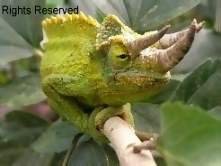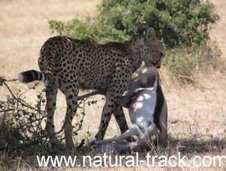Scientific Name: Common (Canis aureus), side-striped (Canis adustus), black-backed (Canis mesomelas)
It's Swahili Name is Bweha. It weighs about15 to 35 pounds and have a lifespan of10 to 12 years. The jackal, a medium-sized carnivore with doglike features and a bushy tail, is widely distributed in Africa, the Middle East and India.
The three species of jackal in East Africa are the golden or common jackal, the side-striped jackal and the black-backed or silver-backed jackal. The golden jackal is somewhat shorter and stockier, and the black-backed is the most slender and upstanding, with noticeably larger ears.
Mainly, they differ in color and choice of habitat. The sandy-colored golden jackal prefers open, grassy plains, while the side-striped jackal lives along water courses with dense undergrowth. This jackal is drabber in color, has a white tip on the tail and indistinct black and white stripes along the sides of the body.
The black-backed jackal is easily recognized by the mantle of black hair on the back that contrasts with the rust-colored body. The black mantle is streaked with white and from a distance has a silvery appearance. The tail is black-tipped, as is that of the golden jackal. The black-backed jackal is usually the most frequently seen as it is more diurnal than the other two species.
The common jackal lives in open savannas, deserts and arid grasslands. Side-striped jackals are found in moist savannas, marshes, bushlands and mountains. The sliver-backed jackal lives primarily in savannas and woodlands. Jackals can best be described as opportunistic omnivores. They cooperatively hunt small or young antelopes such as dikdiks or Thomson's gazelles or even domestic sheep.
They also eat snakes and other reptiles, insects, ground-dwelling birds, fruits, berries and grass. Jackals live singly or in pairs, and are sometimes found in small packs. They are among the few mammalian species in which the male and female mate for life. Yipping calls are made when the family gathers. Members only respond to their own family's calls and ignore those of other individuals.
Although they have long had a reputation as sneaky, skulking scavengers, research has shown jackals to be agile, lithe hunters with close-knit, cooperative family groups. A pair of jackals will move through their territory at a fast trot, stopping frequently to examine something, sniff the air or listen-ready for any opportunity that might provide a meal.
They have been successful in adapting to changing environments. It takes about 10 days for the infants' eyes to open, and for the first few weeks of life they remain in the thickets or holes where they were born. At about 3 weeks they begin to spend time outside playing with their litter-mates. Litters number up to six but usually average two to four. The pups are suckled and fed regurgitated food until they are about 2 months.
By 3 months they no longer use the den, but start to follow their parents, slowly learning the territory and observing hunting behavior. Sometimes pups stay with their parents and help raise their younger brothers and sisters. At times they bring back food to their younger brothers and sisters. At times they bring back food to their younger siblings or babysit them while the parents hunt for food.
Most pup deaths occur during the first 14 weeks of life, so the presence of helpers increases the survival rate. Leopards, hyenas and eagles are jackals' most feared predators. Eagles are small pups biggest threat. Jackals are very cunning and resourceful. Although usually considered scavengers-they do pick over kills made by large carnivores and frequent rubbish dumps-they also hunt and kill a variety of prey. Jackals are noisy. Family or pack members communicate with each other by a screaming yell and yapping, or a sirenlike howl when a kill is located.
PKP-Kenya safari desk
Natural Track Safaris









No comments:
Post a Comment